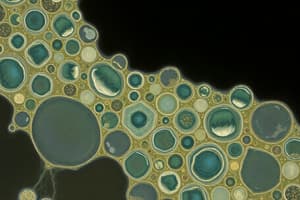Podcast
Questions and Answers
What significant discovery did Robert Brown make in 1833?
What significant discovery did Robert Brown make in 1833?
- The nucleus within cells (correct)
- Cell division mechanisms
- The structure of the cell wall
- The presence of chloroplasts in cells
Who is known as the 'Father of Microbiology' for his early observations of living cells?
Who is known as the 'Father of Microbiology' for his early observations of living cells?
- Robert Brown
- Antonie van Leeuwenhoek (correct)
- Theodor Schwann
- Matthias Schleiden
According to the cell theory, how are living organisms related to cells?
According to the cell theory, how are living organisms related to cells?
- They are composed of one or more cells. (correct)
- They can exist without cells.
- They arise from non-cellular structures.
- They are made exclusively of a single cell.
Which of the following scientists contributed to cell theory but is less credited for it?
Which of the following scientists contributed to cell theory but is less credited for it?
What term did Antonie van Leeuwenhoek use to describe microorganisms he observed?
What term did Antonie van Leeuwenhoek use to describe microorganisms he observed?
What is one reason why cells are small?
What is one reason why cells are small?
What principle of cell theory states the basic unit of life?
What principle of cell theory states the basic unit of life?
Which statement accurately reflects the cell theory?
Which statement accurately reflects the cell theory?
What did Matthias Schleiden propose regarding plant cells in 1838?
What did Matthias Schleiden propose regarding plant cells in 1838?
Which scientist contributed to our understanding that all animal tissues consist of individual cells?
Which scientist contributed to our understanding that all animal tissues consist of individual cells?
What factor does NOT affect the rate of diffusion?
What factor does NOT affect the rate of diffusion?
Which of the following best describes the contribution of Rudolf Virchow to cell theory?
Which of the following best describes the contribution of Rudolf Virchow to cell theory?
What distinguishes unicellular organisms from multicellular organisms?
What distinguishes unicellular organisms from multicellular organisms?
Which of the following scientists is known for inventing the electron microscope?
Which of the following scientists is known for inventing the electron microscope?
How do the functions of fundamentally similar cells differ?
How do the functions of fundamentally similar cells differ?
Which type of organisms are classified as unicellular?
Which type of organisms are classified as unicellular?
What happens to the surface area to volume ratio as a cell increases in size?
What happens to the surface area to volume ratio as a cell increases in size?
Why do smaller cells have an advantage in nutrient and gas exchange?
Why do smaller cells have an advantage in nutrient and gas exchange?
What is the function of the plasma membrane in a cell?
What is the function of the plasma membrane in a cell?
Which of the following best describes cell division?
Which of the following best describes cell division?
How do photosynthetic cells utilize energy?
How do photosynthetic cells utilize energy?
What is stored as chemical energy in plants?
What is stored as chemical energy in plants?
What happens if a cell becomes too large without adaptive mechanisms?
What happens if a cell becomes too large without adaptive mechanisms?
What role do genes play in cellular function?
What role do genes play in cellular function?
Flashcards are hidden until you start studying
Study Notes
Significant Landmarks in Cell Discovery
- In 1667, Antonie van Leeuwenhoek first observed living cells, known as the "Father of Microbiology."
- He utilized single-lensed microscopes he designed himself to examine microbes, discovering bacteria and protozoa, which he called "animalcules."
- In 1833, Robert Brown identified the nucleus within cells, noting its presence in orchid tissues and describing stomata for gas exchange.
- Matthias Schleiden proposed in 1838 that all plants comprise independent, separate cells.
- In 1839, Theodor Schwann declared that all animal tissues consist of individual cells.
- Rudolf Virchow concluded in 1855 that cells arise only from pre-existing cells, reinforcing the continuity of life.
Cell Theory
- Developed primarily by Theodor Schwann and Matthias Schleiden, with contributions from Rudolf Virchow.
- Cell Theory principles include:
- All living organisms are composed of one or more cells.
- The cell is the fundamental structural and functional unit of life.
- All cells originate from pre-existing cells through division.
Cell Diversity
- Cells, membrane-bound units filled with aqueous solutions, can replicate by growth and division.
- The cell is the simplest unit of life in the biological hierarchy.
- Organisms can be unicellular (e.g., Amoeba, Bacteria) or multicellular (e.g., Plants, Animals).
- Cells share basic functions such as energy use, environmental response, and reproduction; however, they exhibit diversity in size and shape.
Why Cells Are Small
- Small cell size enhances the efficiency of diffusion for nutrients and waste.
- Factors affecting diffusion include surface area, temperature, concentration gradient, and distance.
- A higher surface area to volume ratio in smaller cells facilitates better environmental interaction.
- Larger cells may struggle with material transfer, risking cellular function and viability—hence organisms favor small cells.
Basic Properties of Cells
- Cells are highly organized with a plasma membrane delineating content from the external environment, containing cytoplasm, sugars, amino acids, proteins, and organelles.
- Cell reproduction involves division, where genetic material is duplicated and equally distributed to daughter cells.
- Cells acquire and utilize energy, primarily from sunlight through photosynthesis in plants, converting light energy into chemical energy stored as carbohydrates.
- Animals consume these carbohydrates to derive glucose, which is vital for cellular energy supply.
Studying That Suits You
Use AI to generate personalized quizzes and flashcards to suit your learning preferences.




